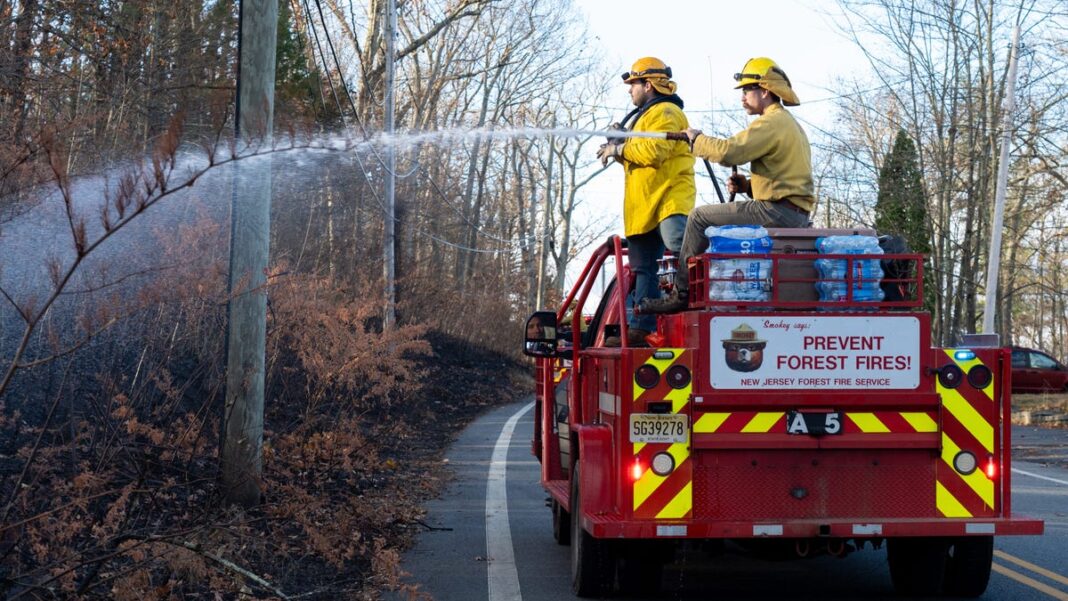Are there solutions in sight as wildfires continue in the Northeast?
The prolonged drought has been affecting a large area from Virginia to New England, prompting warnings of wildfire risks, and there’s no immediate relief expected. In fact, experts suggest that heavy rainfall may be necessary to break this weather cycle.
According to Adam Douty, a senior meteorologist with AccuWeather, some regions may need 7 inches of rain or more to alleviate the dryness, and he does not see any such conditions developing soon.
“There’s a saying that droughts often conclude with floods,” Douty stated in an interview with YSL News. “Let’s hope that’s not the case here, but significant rainfall is definitely required.”
The ideal resolution to the drought would be a prolonged spell of wet weather lasting two weeks or longer, characterized by consecutive storms. Such conditions would signify a major shift for cities like Philadelphia, Washington D.C., and Trenton, New Jersey, which recently experienced record dry days before receiving rain on Sunday.
“Philadelphia went without rain for 42 days, breaking the previous record of 29,” Douty remarked. “They didn’t just set a new record; they shattered it.”
Three New England states under red flag warnings
In Connecticut, Hartford has received just 12% of its typical rainfall since early September. Governor Ned Lamont has issued a Stage 2 Drought Advisory statewide, leading to an emergency burn ban that prohibits outdoor grills, fire pits, campfires, and any open flames in state parks, forests, and wildlife management areas.
The National Weather Service in Boston has released red flag warnings across Connecticut, Massachusetts, and Rhode Island, attributing this to the combination of new wildfires, dry conditions, and gusty northwest winds of 15 to 25 mph expected on Tuesday. Residents are advised to avoid parking on dry grass and to follow burn bans.
Persistent high-pressure system causing issues
This unusual weather pattern has led to wildfires in parks across New York City and created a lingering haze over the metropolis. While some rainfall is anticipated in various areas on Thursday, the upcoming week does not seem to promise the sort of weather needed to remedy the drought, according to Douty.
Douty attributes the ongoing drought to a robust high-pressure system that has been dominant for weeks, effectively suppressing storm systems that might have otherwise moved down from Canada. The combination of a dry atmosphere and parched ground hampers any weak weather fronts attempting to make their way through, he noted. There’s no indication that phenomena like El Niño, La Niña, or even climate change are contributing to this situation.
“This seems to be more of a temporary situation,” he commented. “In a month, the pattern might shift and everyone will be complaining about too much rain.”
The recent storm on Sunday produced between 0.10 and half an inch of rain across multiple regions. Firefighters consider 0.10 inches a “wetting rain,” which is the minimum needed to help control spreading wildfires. The moisture was critically needed in parts of New York and New Jersey, where at least 10 wildfires have been reported across dry woodlands and fields.
“The consecutive days without measurable precipitation have finally come to an end!” the National Weather Service in Mount Holly shared on social media. “While this will not significantly impact the drought, it should temporarily reduce the extreme fire danger.”
Understanding a red flag warning
Red flag warnings issued by the National Weather Service signify that warm temperatures, extremely low humidity, and strong winds are expected, which raises the risk of fire hazards. These warnings are accompanied by specific criteria: relative humidity of 15% or less and wind gusts over 25 mph sustained for three hours within a 12-hour timeframe.
The International Association of Fire Chiefs advises residents to adhere to local fire department recommendations during a red flag warning and to maintain heightened vigilance for any potential sources of ignition.
They suggest refraining from driving on dry grass, ensuring outdoor fires are fully extinguished and never left unattended, soaking ashes and charcoal in water before disposal in a metal container—since remnants can sometimes reignite days later—and reporting unattended fires immediately to 911.
Heat records being set
Climate scientists have noted that 2024 is likely to be recorded as the hottest year ever. Ten months into the year, it is now “virtually certain,” according to the Copernicus Climate Change Service. This year seems poised to also be the first full year where global average temperatures have exceeded 2.7 degrees above pre-industrial levels.
According to Samantha Burgess, the deputy director of the Climate Change Service, we have surpassed critical temperature levels that global leaders and climate experts aimed to maintain below.
The climate service indicated that in order to prevent this year from being the hottest on record, the average temperatures over the next two months must align closely with those of the preindustrial era. Last year holds the record for the highest temperatures previously recorded.
− Dinah Voyles Pulver
(This article has been updated with additional details.)

